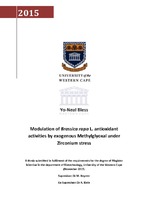| dc.description.abstract | With a decrease in water availability and arable land, and the ever-increasing reports of toxic chemical pollutants, it is crucial to elucidate plants’ mechanisms of adaptability to these abiotic stressors. South Africa alone accounts for approximately 30% of global Zirconium (Zr) production. However, reports on Zr-induced stress in plants are sparse. Increased mining activity leads to soil contamination which subsequently has harmful effects on crop plants. Under normal conditions B. rapa crop plants flourish, they are rapid in their cycling and circumvent the seed dormancy stage which enables them to have high yields over relatively short periods. However, when unfavourable conditions arise, such as exposure to toxic chemicals and metal ions like Zirconium, the development and growth of B. rapa L., much like other crop plants is affected. More specifically, the damaging effects of Zr is not only attributed directly; as with substitutions of biometals [like Iron (Fe)] in various biomolecules rendering them inactive, but more as a consequence of the production of toxic molecules such as reactive oxygen species (ROS) and methylglyoxal (MG). ROS such as superoxide anion (O₂⁻) and hydrogen peroxide (H₂O₂ ) are known to have signalling roles in plants with reports on their involvement in alleviating seed dormancy and seedling development. However, the signalling roles of MG are not known with regards to plant cells and have been reported more so in animal cells; playing vital roles in fat signalling in diseases such as diabetes. Furthermore MG, in plant and animal cells, directly converts oxygen (O₂) to O₂⁻ and thus increases the cell’s oxidative imbalance, leading to cell damage if O₂⁻ is not rapidly dismutated to H₂O₂ and H₂O by superoxide dismutase (SOD). In turn, H₂O₂ is more stable than O₂⁻ and consequently is more toxic to cells over time. Therefore, H O must be removed as well by a collection of enzymes, such as ascorbate peroxidase (APX) and catalases (CAT). In this study, possible stress-signalling of MG in seedlings under normal conditions and Zr-stress were investigated to establish whether MG at a low dose (6 μM) would benefit seedling growth and development, via a proposed preinduction of the B. rapa L. antioxidant system. Therefore, it was proposed that ROS accumulation due to the exogenous application of MG, would incite the activation of antioxidants and thus mitigate the effects of Zr stress. Physiological tests to determine dry weights (figure 3.2.3) and germination percentage (figure 3.2.2) revealed that MG-treated seedlings yielded an improved biomass and early development compared to Zr-treated seedlings and the control. Membrane damage as assessed by lipid peroxidation viz. Malondialdehyde [MDA] (figure 3.2.4) and conjugated dienes [CD] (figure 3.2.5) also indicated less damage in MG-treated seedlings compared to the Zr-treated set. The chlorophyll content observed was prominent (table 3.1). MG-treated seedlings exhibited a 40% and 15.5% increase compared to Zr-treated seedlings and the control respectively. Moreover cell viability had improved in MG-treated seedlings compared to the control, and in MG+Zr-treated seedlings only a slight increase in cell death occurred despite Zr being present. O₂⁻, H₂O₂ and •OH (figure 4.2.1 – 4.2.3) were investigated in B. rapa L. seedlings in response to Zr and MG by spectrophotometric biochemical assays, as well as their scavenging enzymes, MG accumulation and Gly-I activity. Furthermore, BrGLY1 gene expression and Zr-uptake by ICP-OES were performed. Seedlings treated with MG and Zr respectively showed an increase in ROS. However, all of the ROS observed in MG+Zr-treated seedlings were markedly lower compared to Zr-treated seedlings. SOD and CAT activity observed in MG+Zr-treated seedlings had decreased compared to Zr-treated seedlings, whereas APX activity had increased. Gly-I activity and BrGlyI gene expression had increased across all treatments, showing an elicited response to oxidative stress, due to the observed upregulation, as a result of the accumulated MG. The observed Zr-uptake in MG+Zr-treated seedlings was inhibited by 5-fold compared to Zr-treated seedlings. Clear signs of stress were evident in seedlings treated with Zr compared to the control and MG- treated seedlings, the MG-supplemented (MG and MG+Zr) seedlings displayed a vast improvement comparatively. Modulation of antioxidant activity observed in this study is indicative of an incited response to oxidative stress (figure 4.2.4 – 4.2.6). MG revealed distinct involvement in stress-signalling, ROS levels had increased, although not as severely as with Zr-treated seedlings, but seemingly enough to activate antioxidants without eliciting damage. Furthermore, the proposed early-onset activation of antioxidants has been observed in B. rapa L. seedlings of this study, and as such has resulted in improved growth, development and seed germination. The results of this study has therefore negated the previous reports on MG-toxicity (at high concentrations), and has shed light on further properties of this ubiquitous and inevitably-occurring metabolite at low levels. | en_US |

